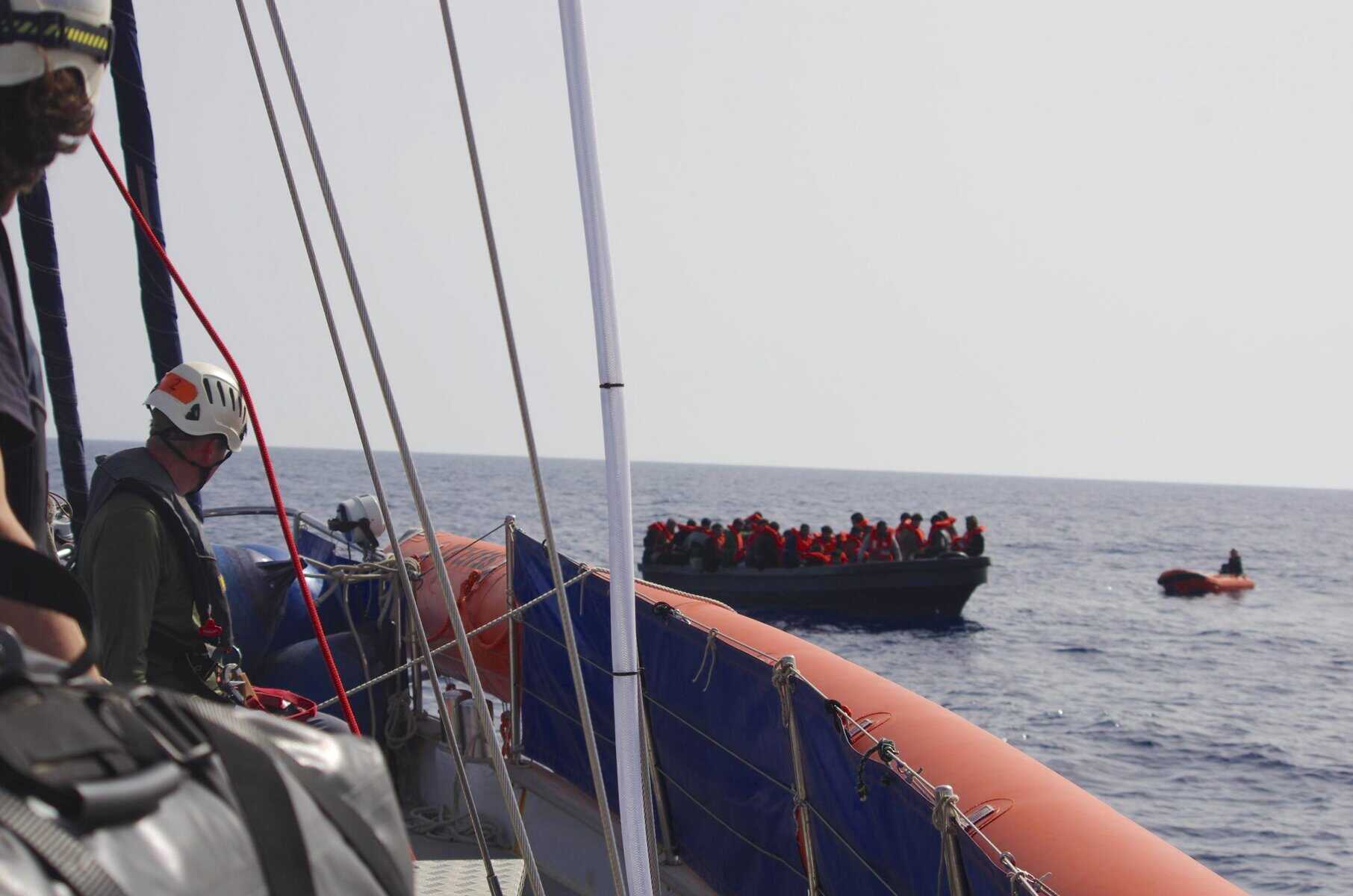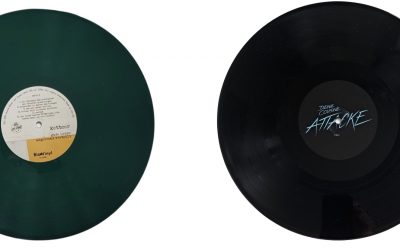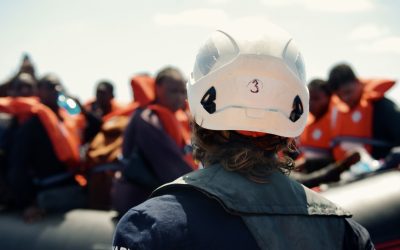Operational report 2 – 2025 (5.4.-26.4.2025)
In April, the NADIR helped 129 people in distress in three different maritime emergencies in the central Mediterranean. After the ship was forced out of the area by a storm, the crew also managed to find people who had been missing for several days.
A trained crew begins its mission.
After intensive training sessions, the NADIR set off on the night of April 8 for this year’s second search and rescue (SAR) mission and quickly reached the operational area off the coasts of Libya and Tunisia.
During the first few days at sea, the crew neither sighted boats in distress nor received Mayday relay. However, she encountered the so-called Libyan Coast Guard (scLCG), which was probably involved in repatriation operations, so-called Pullbackswas involved. An armed scLCG patrol approached the ship, inquired by radio about sightings of boats and observed the crew with binoculars before moving away again.
As there were no reports of distress at sea despite the improved weather conditions, the crew used the time to refine their operational techniques. They tested additional aids such as the SEARCH-WING drone and a thermal imaging camera, which considerably expanded the search options, especially at night. The crew tracked rescue operations in the area, supported an ongoing search that had been reported via ALARMPHONE and helped to extend the reach of rescue coordination.
How do SAR crews find out about boats in distress?
Civilian actors in the central Mediterranean are alerted in various ways. Firstly, via ALARMPHONE, a solidarity network that receives distress calls from people at sea or their relatives. The NGO does extremely important work, as it forwards details such as the coordinates of a distress at sea, the number of people on board and the type of boat to both the authorities and the civilian SAR units in the Mediterranean.
Secondly, crews can also spot boats directly. However, this is less often the case, as it is particularly challenging to locate boats at night, in rough seas or in the midst of fishing boats. To maximize visibility, binoculars, a thermal imaging camera and radar are used in the observation shifts on board the NADIR.
Thirdly, the crews continuously monitor the radio channels on mayday relays, which are distress calls sent out by other boats or aircraft. By law, these must be forwarded to all ships in the vicinity. The Maritime Rescue Coordination Centers (MRCCs) responsible for the respective national waters take over the coordination of rescue operations and are responsible for assigning a safe port after an evacuation.
All three detection methods require enormous attention and perseverance. They are demanding, but essential for finding people in distress at sea.
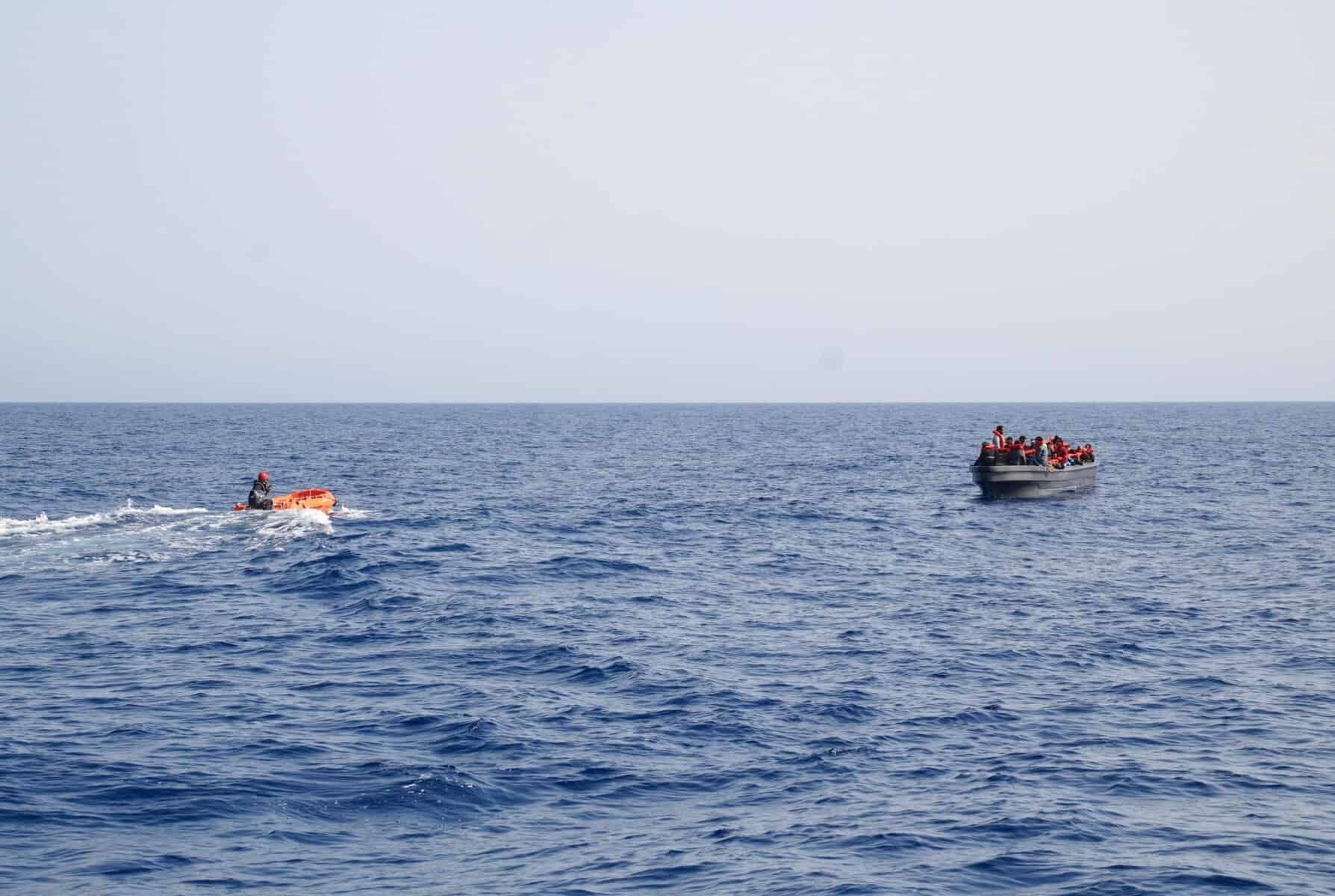
An almost smooth case and a rough ride to Lampedusa
On April 12 at around 1 p.m., NADIR received a distress call via ALARMPHONE about an emergency in the vicinity. The crew immediately interrupted their routine checks and informed the authorities of their intention to respond.
The NADIR reached the reported location and encountered 47 people on board the fiberglass boat. The crew made first contact and distributed life jackets to all the survivors. The mood among the people on board was relatively calm. The survivors reported that they had set out the previous night.
Under still favorable weather conditions and with the approval of the MRCC Rome, the NADIR deployed its dinghy to ensure a safe transfer of the survivors on board the NADIR. By 5 p.m., all the people had safely reached the NADIR. Tired but relieved, they received first aid, water, snacks and rescue blankets to protect them from the cold and wet.
Lampedusa was assigned as a safe haven and the NADIR set course for the north. The crossing began calmly, but strong winds arose overnight. Waves crashed over the bow and drenched the survivors on deck. Some of them struggled to cope with the deteriorating conditions. The crew members took turns to look after them. But the ship is built in such a way that it could not offer them much protection on deck against the high waves.
At dawn, the island of Lampedusa appeared on the horizon, which noticeably lifted the mood on board. Warm porridge helped to recharge our batteries. If we hadn’t found the people in time, they would have been exposed to the same storm front on an unseaworthy fiberglass boat. The NADIR reached the port of Lampedusa in the early hours of the morning. All the survivors disembarked safely, where local civil initiatives and authorities were waiting for them. Law enforcement authorities and Frontexemployees were present. For many of the people, the immediate questioning after this ordeal was an additional burden.
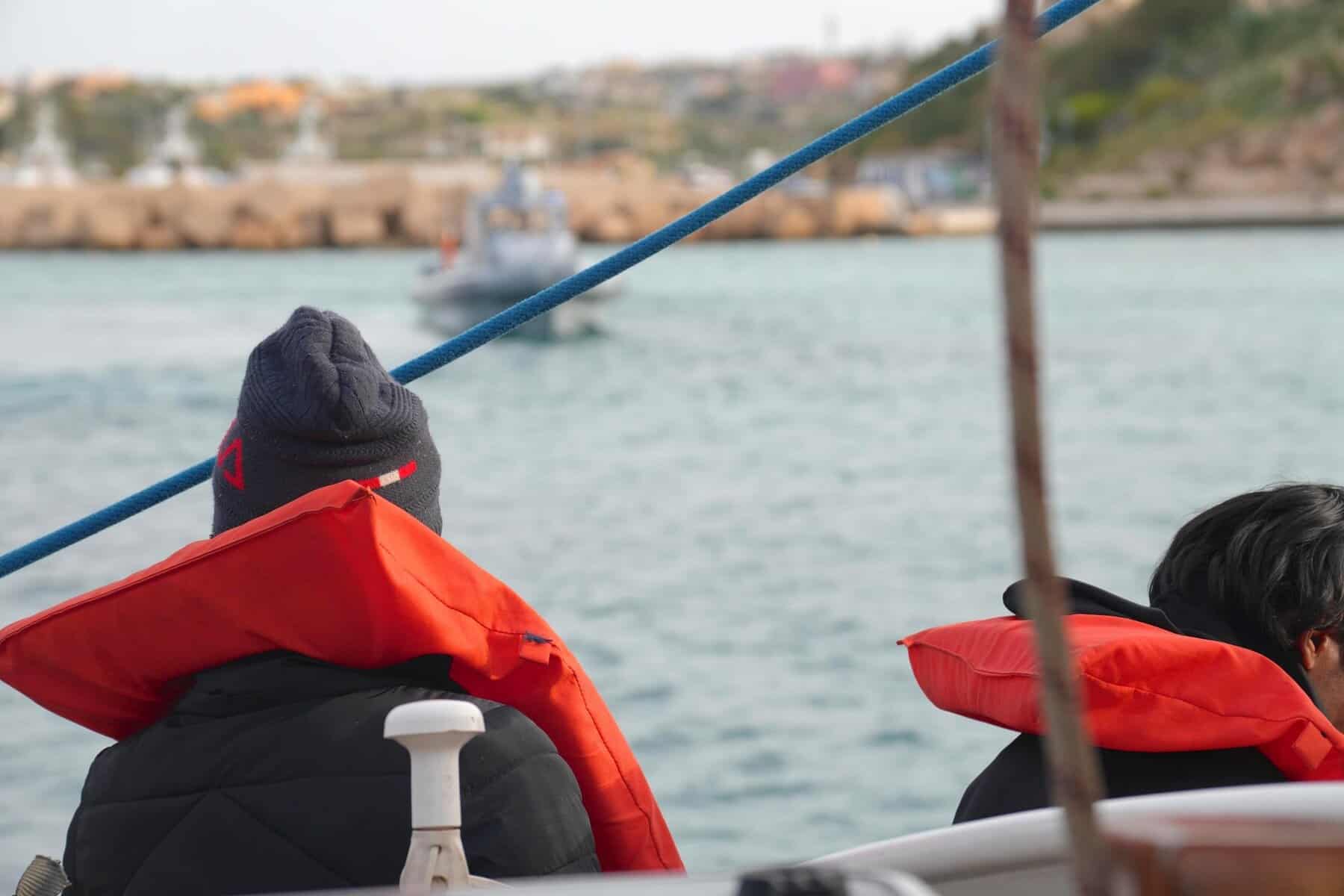
Sometimes all we can do is wait…
After arriving in Lampedusa, the NADIR remained in port and was thus protected from the winds, which had picked up again. The crew waited for news from other civilian ships that were still at sea, including the TROTAMAR III and the AITA MARI. They had to contend with extreme weather within the operational area. When they arrived safely, there was great relief.
A few days later, after the weather improved, the NADIR left Lampedusa and headed south. The weather conditions made departures from Tunisia or Libya seem possible, but over the next seven days the crew of the NADIR neither sighted any boats nor received any reports. For about one or two days, even radio communication was almost completely interrupted, leading the crew to suspect atmospheric interference that had affected signal transmission. Nevertheless, the observation system on board remained active with regular shifts and daily briefings to exchange up-to-date information.
Our crew used this calmer phase to deepen their training, especially for those who were sailing for the first time. Stronger winds and rising waves tested the team’s endurance. Life on a sailing ship in such conditions – while maintaining round-the-clock surveillance – can be quite demanding.
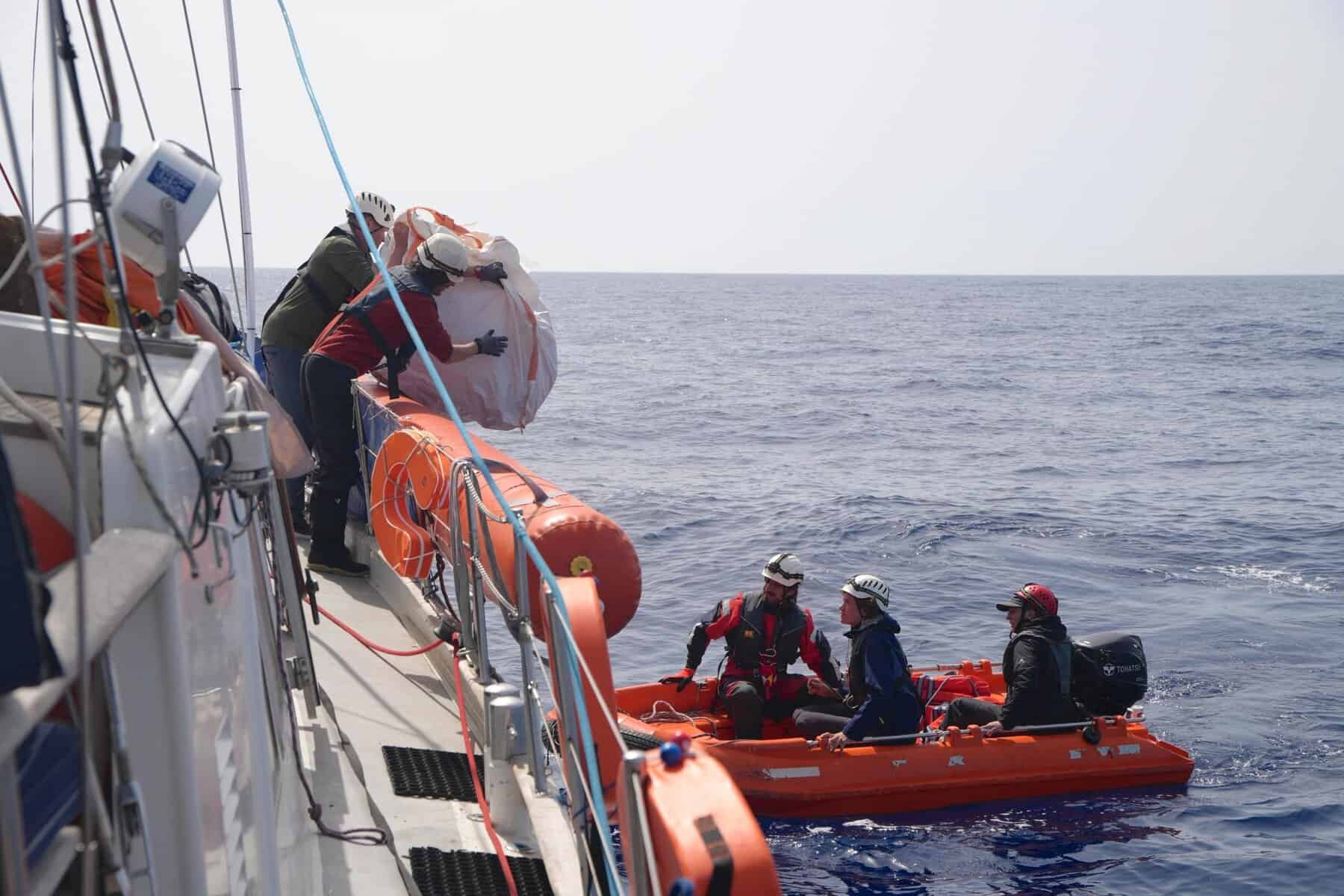
A transgression
When a new storm began to loom on the morning of April 20, the crew decided to return to Lampedusa to seek shelter again. On the way, the NADIR received a report from ALARMPHONE about a boat that had set off from Sfax in Tunisia – presumably an iron boat heading for Lampedusa. As iron boats are structurally unstable and considered particularly dangerous in rough conditions, the crew calculated a possible course direction and began searching in the hope of finding the boat. Despite hours of searching, the increasingly strong waves eventually forced the crew to abandon the search and prioritize safety.
On the way back to Lampedusa, we found an unmarked, empty wooden boat in the immediate vicinity of the island. This sight was unsettling and underlined the dangerous nature of these crossings.
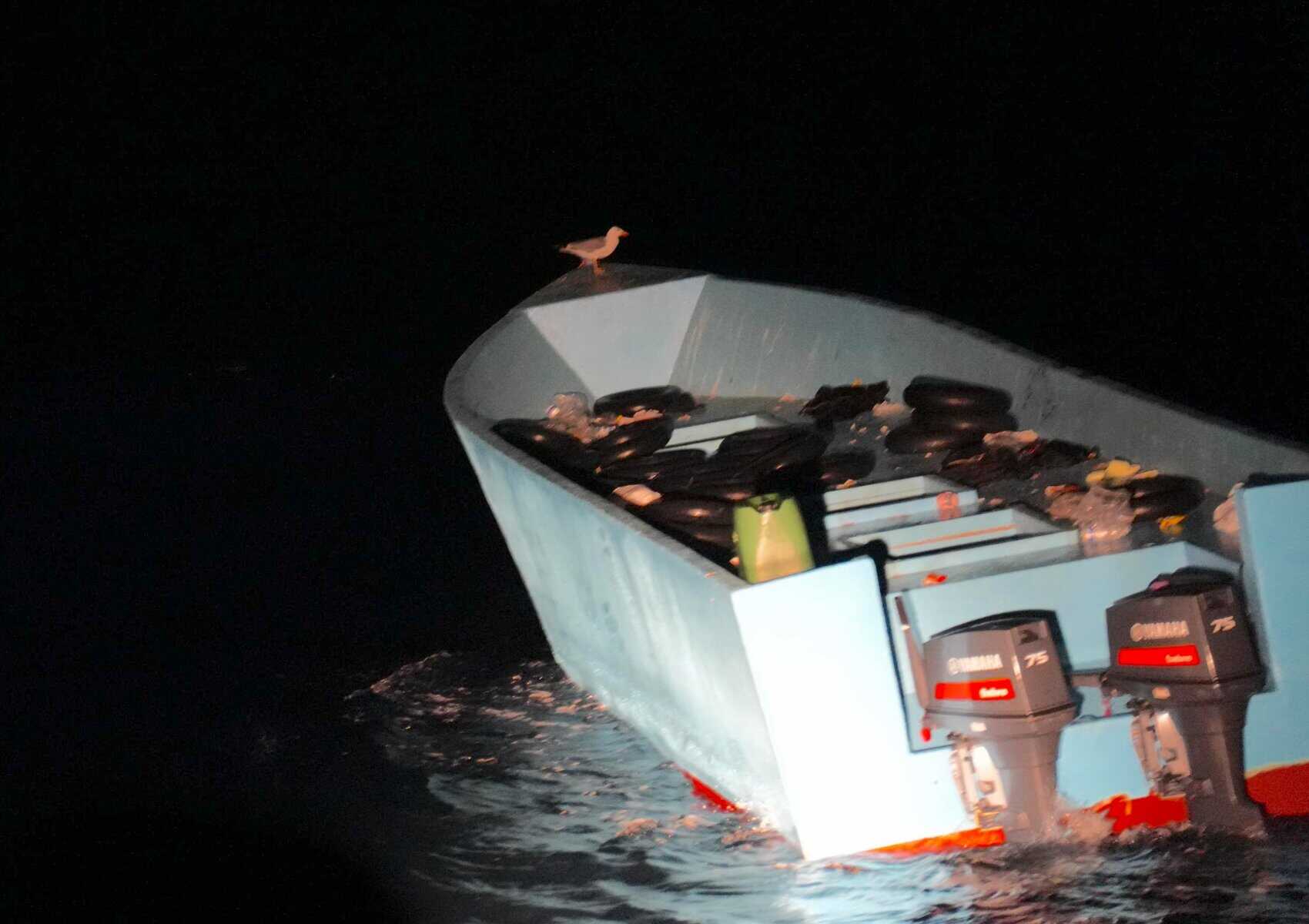
One last shift – and an unexpected encounter.
After about 24 hours in port, the NADIR set sail again on April 22. Although the sea was not yet completely calm, the crew was motivated to return to the deployment area as soon as conditions allowed for meaningful observation.
Given the long period of calm, no one expected immediate contact, but the situation quickly changed when NADIR received a distress call from ALARMPHONE in the evening: A wooden boat had been spotted in distress, was in the immediate vicinity and was heading directly towards the NADIR’s position. Preparations for dinner were canceled and the crew switched to mission mode.
A blue, double-decker wooden boat was spotted on the horizon. The tender team embarked to make first contact and met 45 people on board. Everyone on board appeared calm as the life jackets were distributed.
The authorization to evacuate was delayed by almost an hour. However, as the boat still appeared stable and all passengers were equipped with life jackets, the NADIR waited on standby in the immediate vicinity. As soon as permission was granted, the NADIR cautiously approached and took all the survivors on board. The process went smoothly.
As night fell and the ship was heading north, a small, flickering light appeared in the distance. The shift supervisor on duty decided to investigate. As it was shift change, two other crew members joined the search. As they approached the light, it became clear that it was another boat with people on board. The entire crew prepared for another mission. Although all crew members already had people to care for, the tasks were quickly reassigned, the materials replenished and the support teams got ready – this time with 45 people already on board the NADIR.
A missing boat
The second boat turned out to be an overcrowded and unstable iron boat. The people on board screamed, cried and signaled for help. The boat took on water. As the NADIR approached, the mood changed: relief spread and some people gave free rein to their emotions.
The crew quickly realized that it was the same ship they had been searching for four days earlier before seeking shelter from the storm. The people had been at sea for five days and had already survived severe storms.
There were 92 people on board, including eleven women, two babies aged one and five months and a pregnant woman. The crew gave priority to women, children and people in poor health for transfer by dinghy. All other people were then transferred to the NADIR. Space on board was now extremely limited. Every available space was used to accommodate the rescued people. The crew concentrated on the immediate needs and dealt with chemical burns and cases of severe dehydration and exhaustion.
Two hours later, the Italian Coast Guard informed the NADIR that they would take 87 people on board their ship. The remaining five people stayed on the NADIR. As there was now more space available, the crew could take better care of the group of people remaining on board. A hot pasta meal was distributed and everyone found a place to rest – exhausted but safe.
We prepared the replacement.
Back on land, we prepared for the takeover by crew no. 3. The last few days at sea had been intense, but also characterized by good coordination, mutual trust and the common goal of being present at sea and providing support.
Surveillance operations like these are characterized by uncertainty, long waiting times and sudden decision-making moments. What holds them together is the commitment of all those involved – on board, in the networks on land and among all civilian actors who are committed to a fairer and more humane approach to supporting the freedom of movement of all people.
Bildrechte: Elie Elasmar | RESQSHIP e. V.
